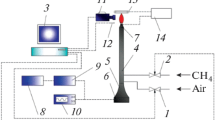Abstract
One of the possible mechanisms of the interaction of a bounded combustion region (flame) with an applied electric field is considered. The investigation is based on application of the electrohydrodynamics (EHD) methods to describe chemically reacting multicomponent nonequilibrium partially ionized gas mixtures. It is shown that zones of space electric charge are formed in the neighborhood of the flame boundaries under certain conditions. These zones can be affected by the electric field. The nature of modification of these zones under the influence of the electric field is investigated.









Similar content being viewed by others
REFERENCES
Jianfeng Fang, Xiaomin Wu, Hao Duan, Chao Li, and Zhongquan Gao, Effects of electrode configurations on the combustion characteristics of premixed methane–air flames, J. Thermal Science and Technology, 2015, vol. 10(1). https://doi.org/10.1299/jtst.2015jtst0020
Tao Xu, Qinglin Chen, Bingjian Zhang, Shushen Lu, Dongchuan Mo, Zhengguo Zhang, and Xuenong Gao, Effects of electric field on micro-scale flame properties of biobutanol fuel, Nature, Scientific Reports, 2016, September 16. https://doi.org/10.1038/srep32938
Park, D.G, Chung, S, and Cha, M., Visualization of ionic wind in laminar jet flames, Combust. Flame, 2017, vol. 184, pp. 246–248. https://doi.org/10.1088/1361-6463/aa94bb
Vatazhin, A.B., Likhter, V.A., Sepp, V.A., and Shul’gin, V.I., Effect of an electric field on the nitrogen oxide emission and structure of a laminar propane diffusion flame, Fluid Dyn., 1995, vol. 30, no. 2, pp. 166–174. https://doi.org/10.1007/BF02029825
Karnani, S. and Dunn-Rankin, D., Detailed characterization of DC electric field effects on small non-premixed flames, Combust. Flame, 2015, vol. 162(7), pp. 2865–2872.
Vlasov, P.A., Pankrat’eva, I.L., and Polyanskii, V.A., Investigation of the EHD structure of flow of a high-temperature gas mixture with a non-uniform source of charged particles, Fluid Dyn., 2022, vol. 57, no. 6, pp. 789–795. https://doi.org/10.1134/S001546282260119X
Calcote, H.F., Mechanisms for the formation of ions in flames, Combust. Flame, 1957, vol. 1(3), pp. 385–403.
Lawton, J. and Weinberg, F.J., Electrical Aspects of Combustion, Clarendon Press, 1969.
Gogosov, V.V., Polyanskii, V.A., Semenova, I.P., and Yakubenko, A.E., EHD equations and transport coefficients in a strong electric field, Fluid Dyn., 1969, vol. 4, no. 2, pp. 18–26. https://doi.org/10.1007/BF01014964
Author information
Authors and Affiliations
Corresponding author
Ethics declarations
The formation of space charge regions in the zones of high gradients of the source of charged particles in flames creates favorable conditions for the hydrodynamic action on them by an external electric field and can serve as one of the explanations for the experimentally observed manifestations of this kind of interaction between the flame and the electric field [1–5]. It should be noted that another aspect of the effect of the electric field on the flame, associated with change in the composition of combustion products (such as the content of NOx, soot formation, etc.) due to the redistribution of ionic components in the mixture under the action of the field, was not considered in this work.
Additional information
Translated by E.A. Pushkar
Rights and permissions
About this article
Cite this article
Vlasov, P.A., Pankrat’eva, I.L. & Polyanskii, V.A. Investigation of the Mechanism of Interaction of the Hydrocarbon Flame with an Electric Field. Fluid Dyn 58, 612–620 (2023). https://doi.org/10.1134/S0015462822601188
Received:
Revised:
Accepted:
Published:
Issue Date:
DOI: https://doi.org/10.1134/S0015462822601188



